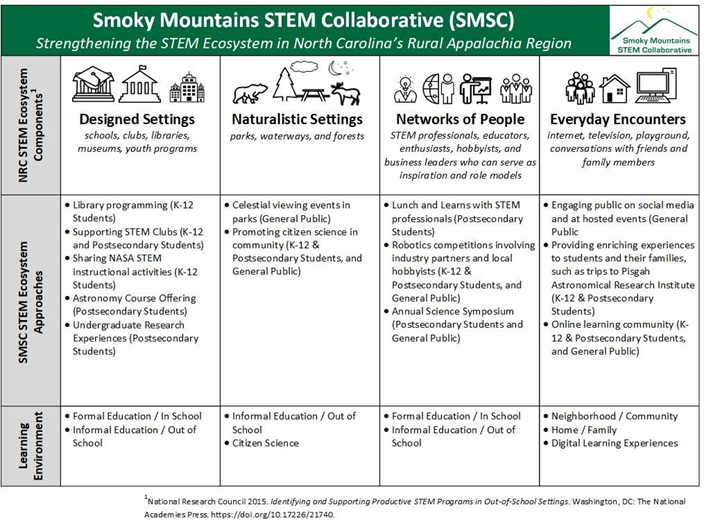Mission Statement
The Smoky Mountains STEM Collaborative is a STEM education ecosystem project serving learners in the southern Appalachians of western North Carolina.
We work with learners from a diverse population, including enrolled members of the Eastern Band of the Cherokee Indians and many first generation college students. These learners are underrepresented not only in STEM fields, but higher education in general. Our continuing mission is to expand and engage the region's public schools, tribal schools, community colleges, and universities in a cohesive, learner-centered STEM ecosystem that leverages Subject Matter Experts (SME's) and science centers to achieve NASA's mission to help learners of all ages "do" science in their own communities.
Core Values
We aim to enrich and sustain rural Appalachia's STEM Ecosystem through increasing scientific literacy and improving the individual science identity of the people in western North Carolina with persistent access to NASA resources.

- Goal 1: Project Goals - Provide the quality experiences promised by our mission and vision statements and reflective of our core values.
- Goal 2: To be truly representative of the community we work with, project leaders will seek to lift up marginalized community members into active roles within the Collaborative.
- Goal 3: Broadening Participation - Project leaders will engage the community beyond the classroom involving learners of all ages and educating them about the Collaborative's mission.
- Goal 4: Funding - Project leaders will maintain and seek out funding to provide quality instruction and experiences for learners of all ages.
- Goal 5: Collaboration - Project leaders will engage in collaboration to broaden the western North Carolina STEM learning ecosystem.
Projected Outcomes
- Goal 1: Projected Goals - Please refer to Figure 1.
- Goal 2: Enlist the aid of Spanish-speaking and Cherokee language subject matter experts (SME) with full acknowledgement and compensation for their expertise.
- Goal 3: Broadening Participation - Expand our social media reach deeper into the community and achieve recognition among the general population of the region in regards to our work and STEM in general.
- Goal 4: Funding - Work with Southwestern Community College's grant writer to seek out and apply for additional funding opportunities.
- Goal 5: Collaboration - Reach out to other organizations throughout the region and connect in meaningful and productive ways.
Action Plans for Areas Needed for Improvement
- Area 1: Organizational Transparency and Communication - Core project staff will seek methods to streamline internal work-flow systems and create outward facing web and social media presence which are easily accessible to the community.
- Area 2: Core project staff will seek out funding and recruit new project staff trained in Spanish language and Cherokee language instruction.
- Area 3: Community Engagement - Core project staff are now members of the Project Committee that will develop a larger Strategic Planning Committee that will engage key community members to contribute to our ongoing improvement process and to continuously monitor progress towards plan goals.
Performance Measures to Use to Assess Progress (indicators, metrics, milestones, etc.)
- Goal 1: Project Goals - Please refer to Figure 1.
- Goal 2 and Area 2: Project will have recruited the aforementioned new team members.
- Goal 3: Broadening Participation - Project will monitor social media interactions and utilize survey questions and other methods to determine increased familiarity with the project within the community.
- Goal 4: Funding - Measured in dollar amount of additional funding and in years of funding.
- Goal 5: Collaboration - Increased involvement with other regional STEM advocacy individuals and groups

Potential and Current Funding
The Smoky Mountains STEM Collaborative is currently funded in cooperative agreement with NASA Science Mission Directorate under grant award No. NNX16AB87A. Any opinions, findings, and conclusions or recommendations expressed in this material are those of the author(s) and do not necessarily reflect the views of the National Aeronautics and Space Administration. Additional funding could be provided via NSF, NASA, or the Department of Education.
References
Industry Expansion Solutions (2021). Year 1 Evaluation Report Phase 2 (2020 - 2025). [Internal NASA document, provided upon request.]

